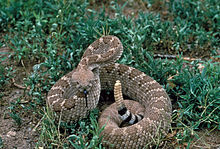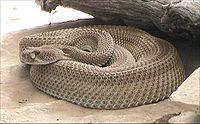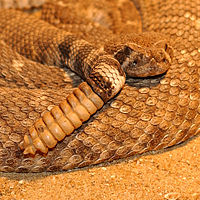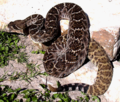- Crotalus atrox
-
Crotalus atrox 
Conservation status Scientific classification Kingdom: Animalia Phylum: Chordata Subphylum: Vertebrata Class: Reptilia Order: Squamata Suborder: Serpentes Family: Viperidae Subfamily: Crotalinae Genus: Crotalus Binomial name Crotalus atrox
Baird & Girard, 1853Synonyms - Crotalus cinereous - Le Conte In Hallowell, 1852
- Crotalus atrox - Baird & Girard, 1853
- Crotalus adamanteus var. atrox - Jan, 1859
- Caudisona atrox var. atrox - Kennicott, 1861
- Caudisona atrox var. sonoraensis - Kennicott, 1861
- C[rotalus]. adamanteus var. atrox - Jan, 1863
- C[rotalus]. atrox var. sonoriensis - Jan, 1863
- C[audisona]. atrox - Cope, 1867
- Crotalus adamanteus atrox - Cope In Yarrow In Wheeler, 1875
- Caudisona atrox var. sonorensis - Boulenger, 1896
- Crotalus atrox atrox - Cope, 1900
- [Cortalus] atrox sonoraensis - Amaral, 1929
- Crotalus atrox - Klauber, 1972
- Crotalus sonoriensis - Golay et al., 1993
- Crotalus atrox - Golay et al., 1993[1]
Crotalus atrox, the "western diamondback rattlesnake", is a venomous rattlesnake species found in the United States and Mexico. It is likely responsible for the majority of snakebite fatalities in northern Mexico and the second greatest number in the USA after C. adamanteus.[4] No subspecies are currently recognized.[2]
Contents
Description
Adults commonly grow to 120 cm (3.9 ft) in length. Specimens over 150 cm (4.9 ft) are infrequently encountered, while those over 180 cm (5.9 ft) are very rare. The maximum reported length considered to be reliable is 213 cm (6.99 ft) (Klauber, 1972). Males become much larger than females, although this difference in size does not occur until after they have reached sexual maturity.[5]
The color pattern generally consists of a dusty looking gray-brown ground color, but it may also be pinkish brown, brick red, yellowish, pinkish or chalky white. This ground color is overlaid dorsally with a series of 24-25 dorsal body blotches that are dark gray-brown to brown in color. The first of these may be a pair of short stripes that extend backwards to eventually merge. Some of the first few blotches may be somewhat rectangular, but then become more hexagonal and eventually take on a distinctive diamond shape. The tail has 2-8 (usually 4-6) black bands separated by interspaces that are ash white or pale gray; this led to the nickname of "coon tail," though other species (e.g., Mojave rattlesnake) have similarly banded tails. There is a postocular stripe that is smoky gray or dark gray-brown and extends diagonally from the lower edge of the eye across the side of the head. This stripe is usually bordered below by a white stripe running from the upper preocular down to the supralabials just below and behind the eye.[5] Its off-white belly is usually unmarked, its anal scale is undivided, and its dorsal scales are extremely keeled, often in rows of 25 to 27 near midbody.[citation needed]
The wide range of this species overlaps, or is close to that of many others. It may be confused with them, but there are differences. The Mohave rattlesnake, C. scutulatus, also has tail rings, but the black rings are narrow relative to the pale ones. The timber rattlesnake, C. horridus, has no tail rings. In the western rattlesnake, C. oreganus, the pale tail rings are the same color as the ground. The tail of the black-tailed rattlesnake, C. molossus, is a uniform black, or has tail rings that are indistinct. The Mexican west coast rattlesnake, C. basiliscus, also has a tail that is mostly dark with rings that are obscure or absent. The tiger rattlesnake, C. tigris, has a relatively small head and large rattle along with a dorsal pattern that consists more of crossbands. The Middle American rattlesnake, C. simus, has a tail without any rings that is generally a uniform gray, as well as a pair of distinctive paravertebral stripes that run down the neck. Members of the genus Sistrurus lack tail rings and have enlarged head plates.[5]
Common names
Western diamondback rattlesnake, western diamond-backed rattlesnake,[2] Adobe snake, Arizona diamond rattlesnake, coon tail, desert diamond-back, desert diamond rattlesnake, fierce rattlesnake, spitting rattlesnake, Texan rattlesnake, Texas diamond-back (rattlesnake),[3] western diamond rattlesnake.[6]
Geographic range
Found in the United States from central Arkansas and southeastern California, south into Mexico as far as northern Sinaloa, Hidalgo and northern Veracruz. Disjunct populations exist in southern Veracruz and southeastern Oaxaca. The type locality given is "Indianola" (Indianola, Calhoun County, Texas, USA).[1]
In the United States it occurs in the following states: central and western Arkansas, Oklahoma excluding the northeast, north-central region and the panhandle, Texas excluding the northern panhandle and the east, southern and central New Mexico and Arizona, extreme southern Nevada, and in southeastern California on either side of the Chocolate Mountains. Records from extreme southern Kansas (Cowley and Sumner Counties) may be based on a natural occurrence of the species, while multiple records from near Kanopolis Reservoir in Ellsworth County seem to indicate a viable (although isolated) population.[5]
In Mexico it occurs in the following states: Nuevo León, Coahuila, Chihuahua, Sonora, extreme northeastern Baja California (state), northern Sinaloa, northeastern Durango, Zacatecas, most of San Luis Potosí, northern Veracruz, Hidalgo and Querétaro. Specimens have been collected in the mountains, northwest of Tehuantepec, Oaxaca on numerous occasions, but have not been reported there since the 1940s.[5]
This species has also been reported on a number of islands in the Gulf of California, including San Pedro Mártir, Santa María (Sinaloa), Tíburon and the Turner Islands.[5]
Habitat
Found in areas ranging from flat coastal plains to steep rocky canyons and hillsides. It is associated with many different vegetation types, including desert, sandy creosote areas, mesquite grassland, desert scrub, and pine-oak forests. Towards the southern edge of its range, this species may be found in thorn forest and tropical deciduous forest.[5]
Behavior
Life expectancy is more than 20 years, but is typically shorter because of hunting and human expansion. Solitary outside of mating season, they are one of the more aggressive rattlesnake species found in North America because they rarely back away from confrontation. When threatened they usually coil and rattle to warn aggressors. There is suspicion that rattlesnakes living around human population centers do not rattle as often because it leads to the snake’s discovery and consequent destruction. However, there is little available evidence of this hypothesis.[citation needed]
In the winter, they hibernate or brumate in caves or burrows sometimes with many other species of snakes. They are poor climbers. Although adult specimens have no natural predators, hawks, eagles, and other snakes have been known to prey on young or adolescent individuals.[citation needed]
Usually inactive between late October and early March, although occasionally they may be seen sunning themselves on warm winter days.[citation needed]
Prey
A comprehensive study by Beavers (1976) on the prey of C. atrox in Texas showed that by weight 94.8% of prey consisted of small mammals.[5] According to Pisani and Stephenson (1991), who conducted a study of the stomach contents of C. atrox in the fall and spring on Oklahoma, mammalian prey included prairie dogs (Cynomys ludovicianus), kangaroo rats (Dipodomys ordii), pocket gophers (Geomys bursarius and Cratogeomys castanops), voles (Microtus ochrogaster), woodrats (Neotoma floridana), pocket mice (Perognathus hispidus and P. flavescens), white-footed mice (Peromyscus leucopus and P. maniculatus), Old World rats and mice (Rattus norvegicus and Mus ssp.), harvest mice (Reithrodontomys megalotis), fox squirrels (Sciurus niger), cotton rats (Sigmodon hispidus), ground squirrels (Spermophilus spilosoma), rabbits (Sylvilagus floridanus), jackrabbits (Lepus californicus), and an unidentified mole species.[5] Klauber (1972) mentions that large specimens are capable of swallowing adult cottontail rabbits and even adult jackrabbits, although he figured the latter required confirmation.[7]
Bird and lizards are also preyed upon, with lizards mostly being eaten by young snakes. Avians include: mockingbirds (Mimidae), quail, a nearly full-grown Gambel's quail, a burrowing owl (Athene cunicularia),[7] a fledgling horned lark (Eremophila alpestris) a black-throated sparrow (Amphispiza bilineata), and an eastern meadowlark (Sturnella magna).[5] Lizards include: a whiptail lizard (Cnemidophorus), Spiny lizards (Sceloporus), a Texas banded gecko (Coleonyx brevis),[7] and a side-blotched lizard (Uta palmeri). One case reported by Vorhies (1948) involved a juvenile specimen that had attempted to eat a horned lizard (Phrynosoma solare), but died after the lizard's horns had punctured its esophagus, leaving the lizard stuck there.[5]
Hermann (1950) reported that C. atrox also feeds on lubber grasshoppers (Brachystola magna). Klauber (1972) once found a single specimen in which the stomach contents included grasshoppers, beetles and ants. However, mammal hairs and an iguanid lizards were also found in the same stomach, which made it more likely that the insects had first been eaten by the mammal or the lizard before they had been eaten by the snake.[7]
They hunt (or ambush prey) at night or in the early morning.
These snakes can go for up to two years without food in the wild. A 5½ month starvation study showed that the snakes reduced energy expenditures by an average of 80% over the length of the study. The snakes also feed from within on energy-rich lipid stores. The most interesting finding was that the snakes grew during the study, indicating that while the snake's mass was shrinking, it was putting its resources into skeletal muscles and bone.[8]
A key participant in the food chain, it is an important predator of many small rodents, rabbits, and birds. In turn it is preyed upon by a variety of larger mammals and birds, such as coyotes, foxes, and hawks. It is primarily a nocturnal animal, hunting for its prey on warm summer nights. It is, however, seasonally diurnal, moving between hunting sites during the day during the cooler spring and fall months.[citation needed]
Venom
Like most other American pit vipers, most of the toxin released is proteolytic. Proteolytic venoms are, in fact, advanced and concentrated fluids that destroy tissues and other cells through intramolecular digestion. The venom of this species is primarily hemotoxic, affecting mainly the body's blood vessels, blood cells and the heart. The venom contains hemorrhagic components called zinc metalloproteinases.[9][10] The venom also contains cytotoxins and myotoxins.[11] In addition to hemorrhage, venom metalloproteinases induce skeletal muscle damage, myonecrosis, which seems to be secondary to the ischemia that ensues in muscle tissue as a consequence of bleeding and reduced perfusion. Microvessel disruption by metalloproteinases also impairs skeletal muscle regeneration, being therefore responsible of fibrosis and permanent tissue loss after bites from this species.[12] General local effects include pain, bleeding, severe swelling, bruising, blistering, and necrosis and systemic effects are variable and non-specific but may include headache, nausea, vomiting, abdominal pain, diarrhea, dizziness, and convulsions. Hemorrhagins causing bleeding is a major clinical effect.[13]
This species has LD50 values of 2.72 mg/kg IV, 20 mg/kg IM and 18.5 mg/kg SC, which is far less toxic than many other rattlesnakes.[14][15] The average venom yield per bite is between 250-350 mg, with a maximum of 700-800 mg.[16][4] Severe envenomation is rare, but possible and can be lethal. Mortality rate of untreated bites is between 10-20%.[13]
Reproduction
 A male crotalus atrox with a pair of intromittent organs called hemipenes, used for reproduction.
A male crotalus atrox with a pair of intromittent organs called hemipenes, used for reproduction.
Rattlesnakes, including C. atrox, are viviparous. Gestation period lasts six or seven months and broods average about a dozen young. However, the young only stay with the mother for a few hours before they set off on their own to hunt and find recluse, thus the mortality rate is very high. Mating occurs in the spring and the females give birth to as many as 25 young, which may be as long as 30 cm (12 in) in length. The young are fully capable of delivering a venomous bite from the moment they are born.
Conservation status
This species is classified as Least Concern (LC) on the IUCN Red List of Threatened Species (v3.1, 2001).[17] Species are listed as such due to their wide distribution, presumed large population, or because it is unlikely to be declining fast enough to qualify for listing in a more threatened category. The population trend is stable. Year assessed: 2007.[18]
They are also heavily collected from the wild, frequently being drawn out of their hiding places with gasoline, and used in Rattlesnake Round-Ups where they are killed for entertainment. Despite this, their population is not considered to be threatened.[citation needed]
Gallery
See also
- List of crotaline species and subspecies
- Crotalus by common name
- Crotalus by taxonomic synonyms
- Crotalinae by common name
- Crotalinae by taxonomic synonyms
References
- ^ a b McDiarmid RW, Campbell JA, Touré T. 1999. Snake Species of the World: A Taxonomic and Geographic Reference, vol. 1. Herpetologists' League. 511 pp. ISBN 1-893777-00-6 (series). ISBN 1-893777-01-4 (volume).
- ^ a b c "Crotalus atrox". Integrated Taxonomic Information System. http://www.itis.gov/servlet/SingleRpt/SingleRpt?search_topic=TSN&search_value=174310. Retrieved 28 November 2006.
- ^ a b Wright AH, Wright AA. 1957. Handbook of Snakes. Comstock Publishing Associates. (7th printing, 1985). 1105 pp. ISBN 0-8014-0463-0.
- ^ a b Norris R. 2004. Venom Poisoning in North American Reptiles. In Campbell JA, Lamar WW. 2004. The Venomous Reptiles of the Western Hemisphere. Comstock Publishing Associates, Ithaca and London. 870 pp. 1500 plates. ISBN 0-8014-4141-2.
- ^ a b c d e f g h i j k Campbell JA, Lamar WW. 2004. The Venomous Reptiles of the Western Hemisphere. Comstock Publishing Associates, Ithaca and London. 870 pp. 1500 plates. ISBN 0-8014-4141-2.
- ^ U.S. Navy. 1991. Poisonous Snakes of the World. US Govt. New York: Dover Publications Inc. 203 pp. ISBN 0-486-26629-X.
- ^ a b c d Klauber LM. 1997. Rattlesnakes: Their Habitats, Life Histories, and Influence on Mankind. Second Edition. First published in 1956, 1972. University of California Press, Berkeley. ISBN 0-520-21056-5.
- ^ "Why Does A Starving Diamond-Back Continue To Grow? Optimism!". http://www.the-aps.org/press/conference/eb06/15.htm. Retrieved April 6, 2006..
- ^ Bjarnason, Jon Bragi; Fox, Jay William (January 1988). "Hemorrhagic Toxins from Snake Venoms". Toxin Reviews 7 (2): 121-209. doi:10.3109/15569548809059729. http://informahealthcare.com/doi/abs/10.3109/15569548809059729. Retrieved 19 November 2011.
- ^ Bjarnason, Jon Bragi; Tu, AT (8). "Hemorrhagic toxins from Western diamondback rattlesnake (Crotalus atrox) venom: isolation and characterization of five toxins and the role of zinc in hemorrhagic toxin e.". Journal of Biochemistry 17 (16): 3395-404. PMID 210790. http://www.ncbi.nlm.nih.gov/pubmed/210790. Retrieved 19 November 2011.
- ^ Calvete, Juan J.; Fasoli E, Sanz L, Boschetti E, Righetti PG (June 2009). "Exploring the venom proteome of the western diamondback rattlesnake, Crotalus atrox, via snake venomics and combinatorial peptide ligand library approaches.". Journal of Proteome Research 8 (6): 3055-67. PMID 19371136. http://www.ncbi.nlm.nih.gov/pubmed/19371136. Retrieved 19 November 2011.
- ^ Gutiérrez, José María; Rucavado, Alexandra (10). "Snake venom metalloproteinases:Their role in the pathogenesis of local tissue damage". Biochimie 82 (9-10): 841-850. doi:10.1016/S0300-9084(00)01163-9. http://www.sciencedirect.com/science/article/pii/S0300908400011639. Retrieved 19 November 2011.
- ^ a b Clinical Toxinology Resource (Crotalus atrox)
- ^ Sean Thomas LD50
- ^ LD50 Menu (Dr. Bryan Grieg Fry)
- ^ Brown JH. 1973. Toxicology and Pharmacology of Venoms from Poisonous Snakes. Springfield, Illinois: Charles C. Thomas. 184 pp. LCCCN 73-229. ISBN 0-398-02808-7.
- ^ Crotalus atrox at the IUCN Red List. Accessed 13 September 2007.
- ^ 2001 Categories & Criteria (version 3.1) at the IUCN Red List. Accessed 13 September 2007.
Further reading
- Yancey FD II, Meinzer W, Jones C. 1997. Aberrant morphology in western diamondback rattlesnakes (Crotalus atrox). Occasional Papers of the Museum of Texas Tech University, 167: 1-4. PDF at Natural Science Research Laboratory. Accessed 26 August 2007.
External links
- Crotalus atrox at the Reptarium.cz Reptile Database. Accessed 26 August 2007.
- Western Diamondback Rattlesnake Facts & Photos at the University of Washington. Accessed 1 September 2008.
- Crotalus atrox care sheet at VenomCenter.com
Categories:- IUCN Red List least concern species
- Crotalus
- Fauna of the Sonoran Desert
- Fauna of the Mojave Desert
- Fauna of the Colorado Desert
- Fauna of the Southwestern United States
- Fauna of Northern Mexico
- Fauna of Gulf of California islands
- Animals described in 1853
Wikimedia Foundation. 2010.








